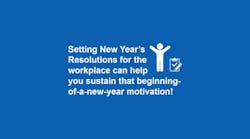A new year often brings with it new challenges and new goals. Coming back to work from our holidays with a fresh perspective, many of us get a surge of motivation in the month of January to do better than before. But with the first month of 2016 behind us now, some of that enthusiasm may be starting to fade.
So how can we sustain that positive energy (and take advantage of it!) in order to set ourselves and our EHS teams up for success this year? Many of us make New Year’s Resolutions for our personal lives, so why not New Year’s Resolutions for work?
Let’s take the time now to consider how these three suggested EHS goals might be able to help you improve upon past performance, boost your team’s reputation within the company and lead to better environmental, health and safety outcomes for everyone you work with.
Ditch the blame game.
You know what I’m talking about. It can be discouraging to see workers behaving unsafely, or to feel as though leaders in the company aren’t placing the kind of emphasis on safety as they should be. Just remember that no one ever wins at the blame game.
It’s very easy to say, “If I had more support from upper management maybe I’d be able to decrease our injury rate.” It can be tempting at times to throw up your hands and say, “Safety culture isn’t the sole responsibility of the safety department, I can’t do it all!”
We all do this from time to time. Indeed, these statements ring true for many EHS professionals. But in moments of frustration, it’s best to remember that placing blame does nothing to solve a problem. In fact, it is nearly always a step in the wrong direction, because blame has no role to play in constructive problem resolution. And nothing hurts safety culture more than pointing fingers.
Set up better systems.
Often, our environment works against us without us even realizing it. This is a great time of year to think about how your existing systems might be sabotaging your efforts to be more efficient or more effective.
A messy desk is perhaps the most basic example. When a colleague hands you a piece of paper, if your default is to add it to a disorganized pile on your desk, then it shouldn’t be a surprise to you when you have a hard time locating that document when you need it. Inbox overflow is a natural digital extension of this problem. Ask yourself if you have appropriate folders and rules set up or if you’re spending too much time deleting spam and trying to hunt down important messages.
Spreadsheet-based systems can be another great place to look for potential improvement, as they’re often rife with hidden productivity costs. Requiring plenty of manual entry, spreadsheets are both time-consuming to maintain and the data is prone to error.
New technology is making it easier than ever for EHS teams to cut down administrative effort and instead spend their time on activities that add more value to their organization. EHS software is streamlining processes with automated workflow and reducing time spent hunting for data with simple reports that highlight the insights that matter.
If you’re relying on outdated systems, 2016 could be the year to do something about it! Start researching the benefits of updating your approach.
Improve communication.
Do you sometimes get the sense that you’re not quite getting through to people? Take for example when you’re delivering training on the proper use of PPE for the tenth time and you look out into the room to see employees’ eyes glazing over. Or when you suspect that your emails about important updates are going unread. Frustrating, isn’t it?
By taking a step back and thinking about how you can improve communication this year – whether it’s corporate-wide communication or just communication within your EHS team – you can potentially increase the impact of all your team’s activities. So take the time to find out what’s working and what isn’t.
Survey your workers to ask them how they’d like to receive important environment, health and safety information. While you’re at it, ask what information they’d like you to communicate that they’re not currently getting from you, and ask if they have any ideas on how they could get more out of your safety meetings and training sessions. Who knows, you might be inspired by their responses.
This post appeared originally on the Intelex Health and Safety blog.
Alison Grenkie is a Product Marketing Manager at Intelex, a company that delivers EHS and quality management software solutions. She is a sustainability enthusiast and an avid writer who enjoys sharing ideas, best practices and other insights that can help EHS professionals achieve better business outcomes.
